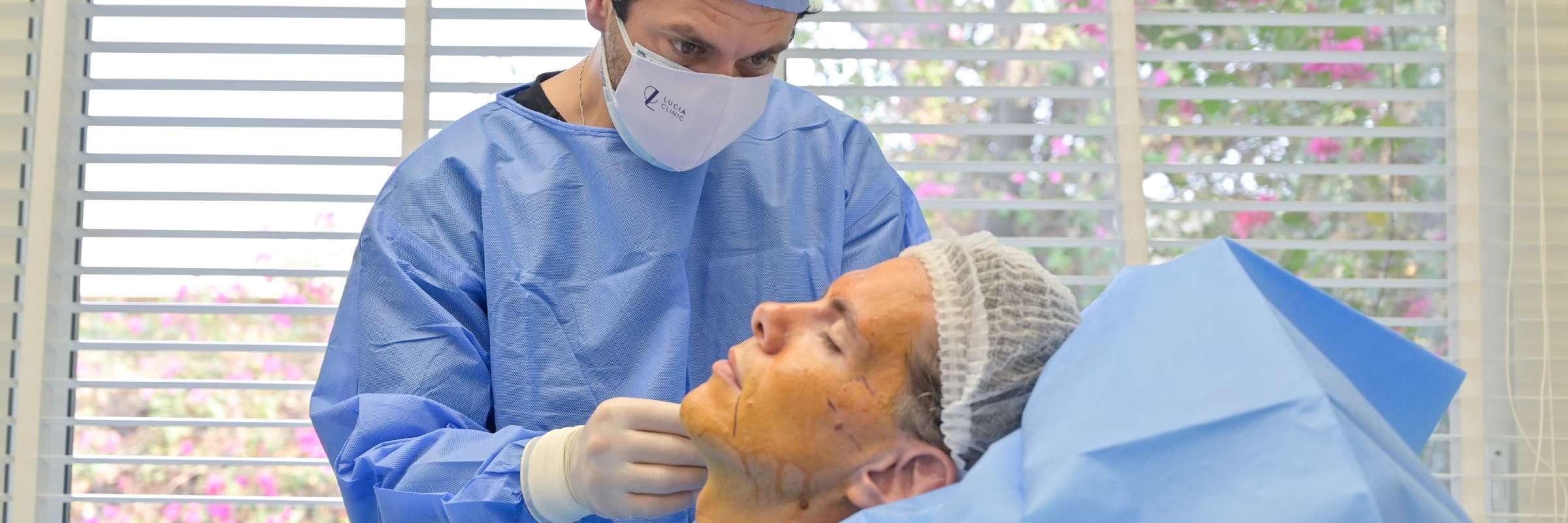| Will I be awake or asleep during the surgery? | Local anesthesia with sedation or general anesthesia can be used. |
| Do I stay in hospital after surgery? | Might be needed to stay for 1 night. |
| What is the recovery time? When can I return to work/exercise? | 2-6 weeks , depending on the extent of the surgery. |
| How long will the surgery last? | 2-4 hours. |
| How long until the final results of surgery are visible? | 6 months after the procedure. |
What is Fat Grafting?
Fat grafting, also known as lipomodeling or fat transfer is a plastic surgery that involves transferring fat from one body area to another. Fat grafting is also called autologous fat transfer which means that it is the most biocompatible dermal filler – the patient’s own fat is used in the surgery. Therefore the risk of adverse reactions, like allergy, is minimal. The procedure achieves long-lasting and natural-looking results.
The goals of this surgery can be to improve the targeted area or enlarge it with the injected fat. The excess fat is removed from one body area with liposuction and then it is injected into the other area which needs rejuvenation or augmentation. The fat can be taken from the abdomen or thighs and then transferred to the breasts or buttocks. This surgical procedure has been safely used since the 1990s for enhancing the look of the face, hands, hips, buttocks and breasts. Fat grafting also has therapeutic effects and can heal scars and wounds.
What Can Fat Grafting Address?
Fat grafting, also known as fat transfer, is a versatile treatment that addresses various aesthetic concerns by restoring volume and enhancing contours. This advanced technique uses fat harvested from your body to achieve natural and long-lasting results. Here are some key areas it can address.
Face
With fat transfer, patients can achieve a more youthful appearance by adding volume to hollow areas of temples or forehead and reducing the visibility of nasolabial folds, marionette lines and wrinkles and fine lines around the mouth. The injected fat also adds volume to the cheeks so that they look prominent again. On the whole, the procedure makes the face appear fresh, plump and rejuvenated because it improves the overall texture of the skin. Moreover, the transferred fat has therapeutic effects and can heal scars and wounds on the face. It eliminates acne, surgical and other scars because it is rich in stem cells that heal the skin.
Breasts
This plastic surgery can make breasts more symmetrical and enhance their contours. It can also restore the volume that is lost due to pregnancy, weight loss or aging. Patients can increase their breast size by one whole cup and achieve natural-looking results.
Hips
Fat grafting Dubai offers can add volume to the hips and create more feminine contours and a better-looking waist and hip.
Buttocks
With this procedure, patients can achieve perkier buttocks. They can also make their buttocks larger and rounder. Fat grafting for buttocks augmentation is called Brazilian butt lift. It also improves saggy skin and loss of natural buttocks shape. After the procedure, the buttocks look youthful and enhanced again.
Hands and feet
Fat grafting is an effective method of restoring lost volume in the hands and feet. It makes the skin look rejuvenated and plumper which greatly reduces the appearance of veins, tendons and bones. It also eliminates wrinkles and fine lines.
Who Is an Ideal Candidate?
The ideal candidates for this procedure need to have excess fat on other body parts, from which the surgeon can extract the fat for injection. Therefore, this surgery has a double benefit – when the fat is eliminated from the donor area, the patient is left with a slimmer and a better-contoured abdomen or thighs for example. On the other hand, once the surgeon injects the fat into the targeted area, the patient gets more volume in the breasts or buttocks for example.
The ideal patient should be close to his/her ideal weight and generally fit and healthy. It is better if the patient is a non-smoker and has healthy habits like a balanced diet and regular exercise. This greatly contributes to faster healing after the surgery. Also, the patient shouldn’t suffer from any medical conditions that would interfere with the healing.
What Does the Procedure Involve?
The fat grafting procedure includes three steps:
- Liposuction of the fat from the donor site – In this step, the plastic surgeon makes tiny incisions in the skin and uses thin tubes called cannulas to reach and extract the fat. Liposuction is performed very precisely so that the surrounding tissue is left undamaged. The incisions are closed with stitches.
- Purification of the extracted fat – once the fat is extracted it is purified through centrifugation and draining. This way all unnecessary elements are separated like dead cells, debris and excess fluid.
- Injection of the fat into the targeted area – this is the final step. When the fat is purified and prepared, it is injected into the subcutaneous tissue of the targeted area which ensures a good supply of blood for the injected fat. After the procedure, there is no need for stitches.
The amount of fat that is injected into the targeted area depends on the size of the area and the patients’ specific needs. The amount is usually measured in cc’s.
Downtime and Side Effects of the Surgery
Side effects that can be expected after the procedure are swelling, bruising and numbness. After the body has fully healed, there may be small but barely visible scars in the areas where the fat was extracted. There is no risk of allergic reaction or infection because the procedure involves using the patient’s own fat. The downtime for fat grafting depends on the areas treated and the extent of the procedure. Typically, you can expect a recovery period of one to two weeks, during which swelling, bruising, and mild discomfort are common
The most important thing is to follow the surgeon’s recovery recommendations. For instance, if the patient got a fat transfer to her breasts, it’s best to sleep on her back for a couple of weeks. If on the other hand, the patient got a fat transfer to the buttocks, it’s best to sleep on the stomach. In the case of full-face beautification with fat transfer, it’s best to sleep in an elevated position to eliminate swelling. The patient should avoid strenuous exercise, except for some light activities around the house.
Benefits of Fat Grafting Dubai Offers
The benefits of fat grafting for body contouring include:
- It is one of the most natural ways of enhancing beauty. It can add volume and contour or improve the shape of different body areas with the patient’s own fat. There is no risk of allergic reactions.
- It makes the skin appear more youthful. This is especially true in the case of full-face beautification. Patients can eliminate the signs of aging and restore the younger-looking appearance of their faces.
- Each fat transfer surgery is customized. Every patient is different and needs individual attention. Therefore, during the consultation with the plastic surgeon, the patient can express his/her aesthetic concerns and the surgeon creates a treatment plan that addresses the patient’s specific needs and expectations.
- Fat transfer achieves long-lasting results. Also, it achieves natural-looking results. If the patient doesn’t fluctuate too much in weight the results can last for many years.
- Fat has healing properties. It can adapt to the area it was transferred to and re-grow new blood supply. This way it can improve acne, trauma and surgical scars.
- The recovery period is quite short. It can last between 2 and 6 weeks, depending on the targeted area and the technique used in the surgery. If the patient follows the surgeon’s recovery recommendations, the downtime can be even shorter.
What You Should Know Before the Procedure
Initial consultation with the plastic surgeon is mandatory. During the consultation, the patient can express his/her aesthetic wishes and goals which he/she wants to achieve with fat transfer. The surgeon examines the patient and determines which body area will be the best as a donor site for fat extraction. Then the surgeon creates a customized treatment plan that will address the patient’s specific needs and issues.
The surgery lasts for a few hours and is usually done under general anesthesia. The patient can go home soon after the surgery is over unless advised otherwise.
If the targeted area is larger like the buttocks, for example, the patient may need more than one session to achieve the best results. This is because the injected fat might be reabsorbed by the patient’s body and some of the added volume is lost. Therefore the surgeon will inject some extra fat in order to minimize this loss.
After the procedure, the patient should arrange for someone to drive him/her home.
During the recovery period, it is not advisable to drive for some time, especially if the patient has had BBL surgery. Also, the surgeon may advise the patient to wear a compression garment to speed up the recovery. The patient should also take a week or two off the work to fully recover.
Related Treatments at Lucia Clinic
At Lucia Clinic Dubai, we offer a range of treatments that complement fat grafting, enhancing your natural beauty with precision and care. Here are some of our related services:
- Dermal Fillers: Utilize hyaluronic acid-based injectables to restore volume, smooth wrinkles, and enhance facial contours, providing immediate and natural-looking results.
- Ultherapy: Employ advanced ultrasound technology to lift and tighten the skin on the face, neck, and décolletage, stimulating collagen production for a youthful appearance.
- HydraFacial: Experience a multi-step facial treatment that cleanses, exfoliates, and hydrates the skin, leaving it radiant and rejuvenated with no downtime.
- Alma Hybrid Laser Treatment: Benefit from a cutting-edge laser procedure that combines ablative and non-ablative technologies to address skin concerns such as scars, pigmentation, and texture irregularities, promoting supreme skin regeneration.
- JetPeel Treatment: Indulge in a non-invasive treatment that uses jet technology to infuse oxygen and nutrients deep into the skin, improving hydration, reducing signs of aging, and enhancing overall skin health.
Redefine Your Contours with Precision and Care
Achieve your aesthetic goals with the precision and expertise that define Lucia Clinic Dubai. Whether restoring volume or enhancing your contours, fat grafting Dubai offers a natural and personalized solution. Explore this luxurious treatment and experience a transformation tailored to your unique beauty. Contact Lucia Clinic today to schedule your consultation and discover the artistry of aesthetic care.





